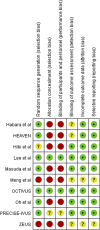Effect of ezetimibe-statin combination therapy vs. statin monotherapy on coronary atheroma phenotype and lumen stenosis in patients with coronary artery disease: a meta-analysis and trial sequential analysis
- PMID: 38803434
- PMCID: PMC11128550
- DOI: 10.3389/fphar.2024.1343582
Effect of ezetimibe-statin combination therapy vs. statin monotherapy on coronary atheroma phenotype and lumen stenosis in patients with coronary artery disease: a meta-analysis and trial sequential analysis
Abstract
Background: Evidence indicates that the addition of ezetimibe to statin therapy reduces cardiovascular events. However, the impact of ezetimibe-statin combination therapy on coronary plaque regression, plaque stabilization, and diameter stenosis remains a matter of controversy.
Methods: We performed electronic searches in PubMed, Web of Knowledge, and the Cochrane Central Register of Controlled Trials to identify eligible trials assessing the effects of ezetimibe-statin combination therapy versus statin monotherapy reporting at least one outcome among total atheroma volume (TAV), minimum fibrous cap thickness (FCT), lumen volume (LV), and lumen area (LA) derived from intravascular imaging modalities of intravascular ultrasound (IVUS) and optical coherence tomography (OCT). We used the random-effects model and performed trial sequential analysis (TSA) during this meta-analysis.
Results: Eleven articles with a total of 926 individuals (460 in the dual-lipid-lowering therapy group and 466 in the statin monotherapy group) were included in the final meta-analysis. Compared to statin monotherapy, ezetimibe-statin combination therapy was associated with significantly decreased TAV [WMD = -3.17, 95% CI (-5.42 to -0.92), and p = 0.006], with no effect on the LV of the coronary artery [WMD = -0.52, 95% CI (-2.24 to 1.21), and p = 0.56], the LA of the coronary artery [WMD = 0.16, 95% CI (-0.10-0.42), and p = 0.22], or minimum FCT thickness [WMD = 19.11, 95%CI (-12.76-50.97)].
Conclusion: In patients with coronary artery disease, ezetimibe-statin combination therapy resulted in a significant regression in TAV compared to statin monotherapy, whereas no overall improvements of minimum FCT or lumenal stenosis were observed.
Keywords: atheroma plaque; coronary plaques; ezetimibe; intravascular ultrasound; optical coherence tomography; statin.
Copyright © 2024 Zhang, Xu, Duan, Wang and Han.
Conflict of interest statement
The authors declare that the research was conducted in the absence of any commercial or financial relationships that could be construed as a potential conflict of interest.
Figures






Similar articles
-
Can proprotein convertase subtilisin/kexin type 9 (PCSK9) inhibitors regress coronary atherosclerotic plaque? A systematic review and meta-analysis.Am J Transl Res. 2023 Jan 15;15(1):452-465. eCollection 2023. Am J Transl Res. 2023. PMID: 36777825 Free PMC article. Review.
-
The impact of statin-ezetimibe combination therapy versus statin monotherapy on coronary plaque regression in patients with acute coronary syndrome: a meta-analysis.J Pak Med Assoc. 2024 Jun;74(6 (Supple-6)):S23-S27. doi: 10.47391/JPMA.S6-ACSA-05. J Pak Med Assoc. 2024. PMID: 39018135
-
Intensive statin versus low-dose statin + ezetimibe treatment for fibrous cap thickness of coronary vulnerable plaques.Chin Med J (Engl). 2020 Oct 20;133(20):2415-2421. doi: 10.1097/CM9.0000000000001067. Chin Med J (Engl). 2020. PMID: 32889912 Free PMC article.
-
Impact of Dual Lipid-Lowering Strategy With Ezetimibe and Atorvastatin on Coronary Plaque Regression in Patients With Percutaneous Coronary Intervention: The Multicenter Randomized Controlled PRECISE-IVUS Trial.J Am Coll Cardiol. 2015 Aug 4;66(5):495-507. doi: 10.1016/j.jacc.2015.05.065. J Am Coll Cardiol. 2015. PMID: 26227186 Clinical Trial.
-
The effect of combined ezetimibe and statin therapy versus statin therapy alone on coronary plaque volume assessed by intravascular ultrasound: A systematic review and meta-analysis.J Clin Lipidol. 2018 Sep-Oct;12(5):1133-1140.e15. doi: 10.1016/j.jacl.2018.06.001. Epub 2018 Jun 13. J Clin Lipidol. 2018. PMID: 30318063
Cited by
-
Comparative efficacy of intravascular ultrasound and fractional flow reserve in guiding percutaneous coronary intervention.Medicine (Baltimore). 2025 Mar 21;104(12):e41743. doi: 10.1097/MD.0000000000041743. Medicine (Baltimore). 2025. PMID: 40128060 Free PMC article.
References
-
- Baigent C. J. L., Keech A., Kearney P. M., Blackwell L., Buck G., Pollicino C., et al. (2005). Efficacy and safety of cholesterol-lowering treatment: prospective meta-analysis of data from 90,056 participants in 14 randomised trials of statins. Lancet 366, 1267–1278. 10.1016/S0140-6736(05)67394-1 - DOI - PubMed
-
- Biccirè F. G., Budassi S., Ozaki Y., Boi A., Romagnoli E., Di Pietro R., et al. (2023). Optical coherence tomography-derived lipid core burden index and clinical outcomes: results from the CLIMA registry. Eur. Heart Journal-Cardiovascular Imaging 24 (4), 437–445. 10.1093/ehjci/jeac110 - DOI - PubMed
-
- Bohula E. A., Giugliano R. P., Cannon C. P., Zhou J., Murphy S. A., White J. A., et al. (2015). Achievement of dual low-density lipoprotein cholesterol and high-sensitivity C-reactive protein targets more frequent with the addition of ezetimibe to simvastatin and associated with better outcomes in IMPROVE-IT. Circulation 132 (13), 1224–1233. 10.1161/CIRCULATIONAHA.115.018381 - DOI - PubMed
Publication types
LinkOut - more resources
Full Text Sources
Research Materials
Miscellaneous

